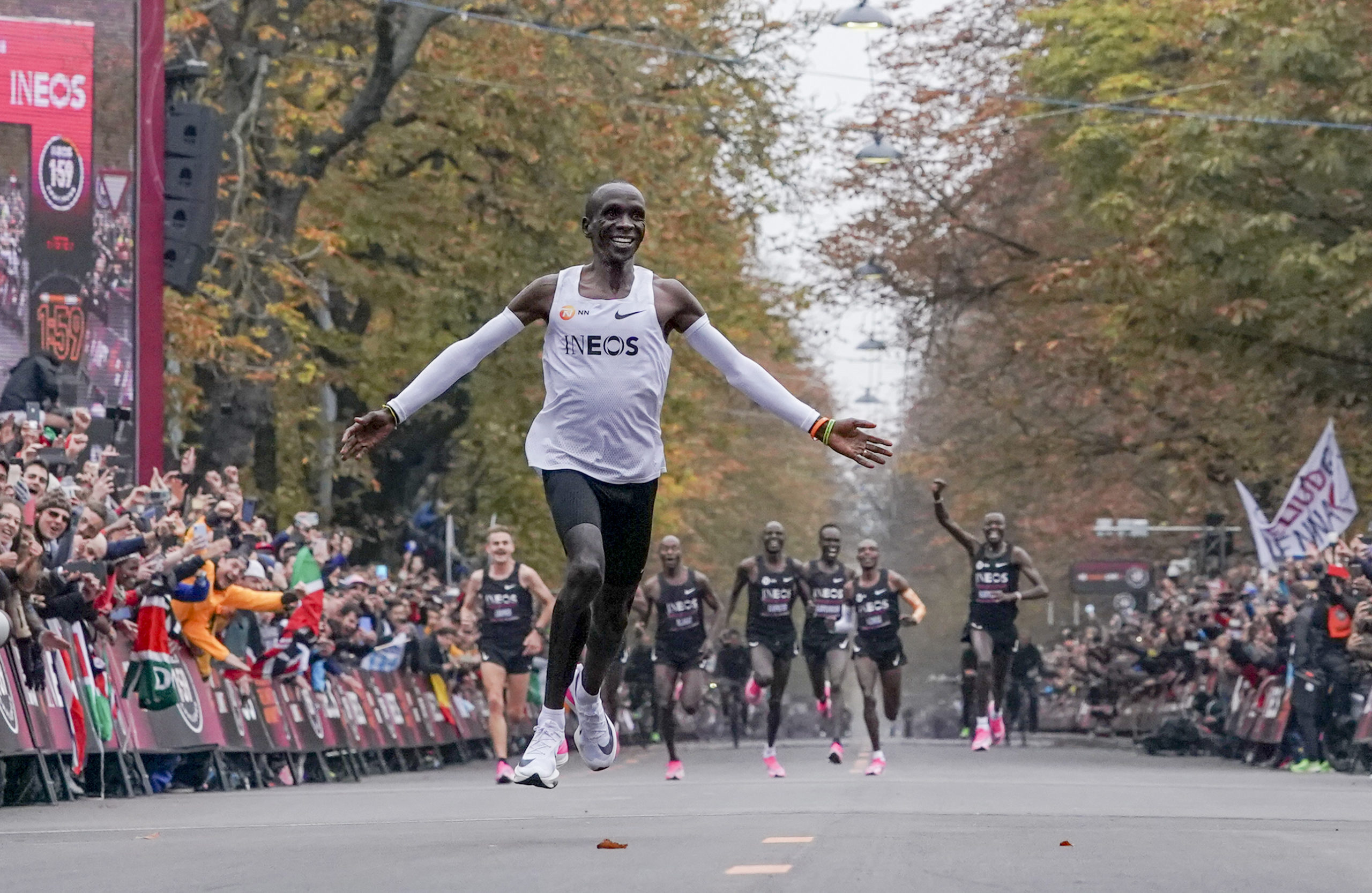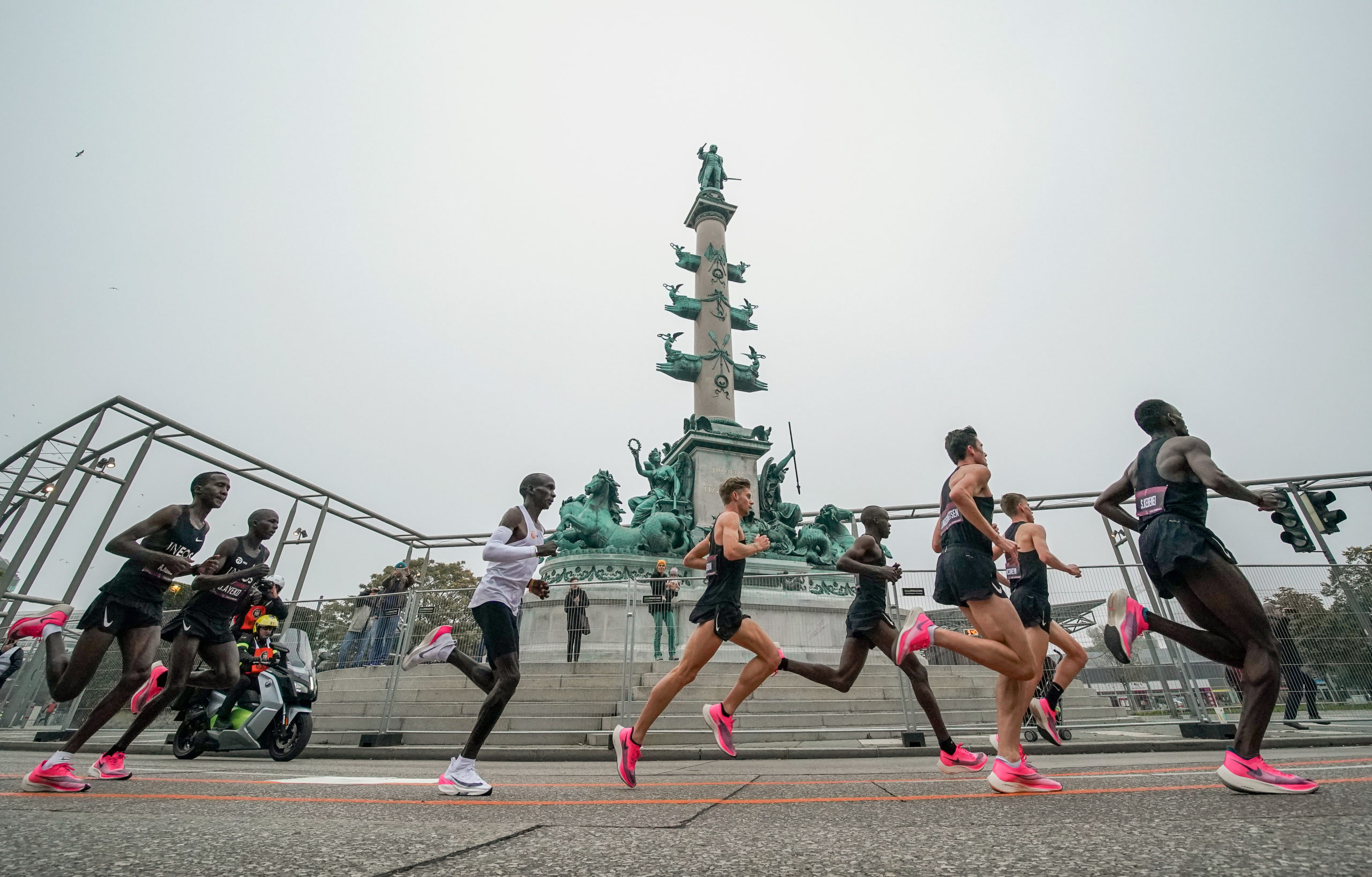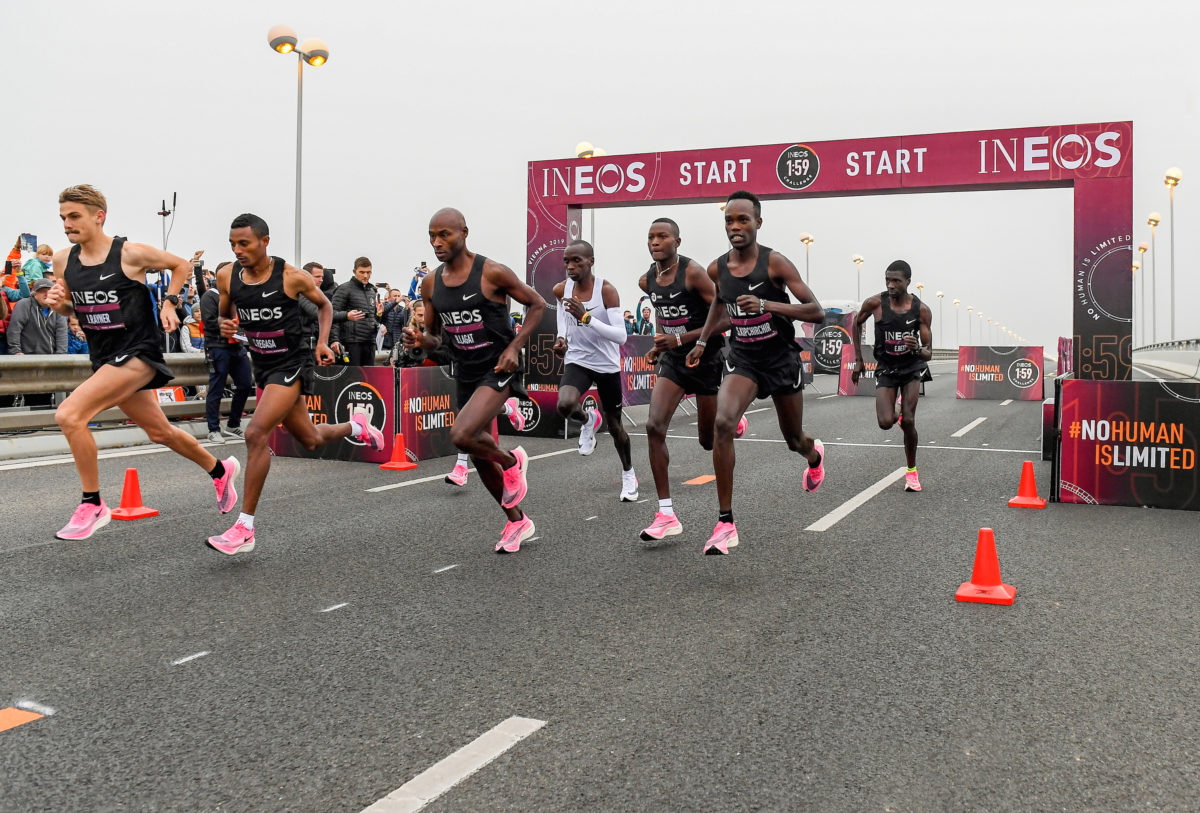
On October 12 2019, Eliud Kipchoge ran a marathon in 1:59:40 at a special event in Vienna, Austria, smashing the previously untouched two-hour milestone. With pacemakers ecstatic in the background, he cut a graceful, joyous figure as he crossed the line, gliding into athletics folklore (if not quite the world record books) for his achievement. But in images of the race, what really catches the eye are the shoes worn by the group of runners: the garish pink Nike trainers on the feet of Kipchoge’s pacemaking colleagues, paired with black shirts against which his white outfit stands out—the purity of the chosen athlete. Kipchoge himself wears white Nike shoes, the thick sole appearing faintly ridiculous in comparison with his slender, muscular legs; the instantly recognisable swoosh a symbol of both technological excellence and relentless corporate fashioning.
Elite sport is existentially wedded to sponsorship funding and endorsements, and many people are accustomed to seeing uniformity in equipment, clothing and branding. It is a necessity, something the sporting world needs, but it often threatens to infringe on values of fairness and sportsmanship in competition. With Nike and the two-hour marathon, this relationship became blurred: a huge company pouring millions of dollars into a single sporting goal, its motivation questioned by both competitors and running purists. Kipchoge’s achievement was momentous; even without it, he still holds the official marathon world record and is widely recognised as one of the greatest ever distance runners. But his triumph in Vienna is a story which cannot be told without touching on design, technology, innovation and ethics.
- Joe Toth, INEOS 1:59 Challenge, Vienna, 2019. Courtesy Bob Martin Photography
Nike had been planning an assault on the two-hour marathon barrier for five years before it was finally broken. The company partnered with National Geographic in 2016 to create a highly stylised, space race-esque documentary about Kipchoge’s first attempt at reaching the milestone at a Formula 1 racetrack in Monza, Italy in 2017 (he clocked a time of two hours and 25 seconds that day). The 30 pacemakers running in specific formations were employed to reduce drag for Kipchoge, one of the successive attempt’s features which invalidated them from official world record consideration (a black Tesla leading the athletes around the track with constant updates on their split times, and a laser pointing out the optimum track route, was another). “Breaking2 wasn’t just a race or an experiment,” Nike said, “it is a model for how much faster we can go when cutting-edge science meets unwavering passion and commitment to the goal.”
“Kipchoge’s triumph in Vienna is a story which cannot be told without touching on design, technology, innovation and ethics”
It’s a logic which extends not just to the endeavour itself, but to the shoes crafted to achieve it. Part of the meticulous preparations included designing a bespoke shoe for the event in Monza: the Nike ZoomX Vaporfly 4%, which after months of disguised testing by Nike athletes was unveiled in March 2017. The main point of controversy is the shoe’s design: put simply, it contains an embedded carbon-fibre plate within the foam, which is used in aircraft insulation. The plate angles the shoe to propel the wearer forward, giving the sensation of running slightly downhill. Subsequent trials revealed that runners wearing the shoe expended 4 percent less energy on average, hence the product’s name, though the overall effect, especially on elite athletes, is continuously contested.
In January this year, World Athletics introduced an immediate ban on shoes that have a sole thicker than 40mm, and pledged to investigate potentially non-compliant products. From 30 April, any shoe must have been available for retail for four months before it can be used in competition; although the Nike Vaporfly range was unaffected by the changes, the prototype worn by Kipchoge for his Vienna effort—Nike’s Air Zoom Alphafly Next%—is now banned from competition. Valid world records set while wearing Vaporflys, such as Brigid Kosgei’s smashing of the women’s marathon world record by 81 seconds in Chicago last year, will still stand.

Joe Toth, INEOS 1:59 Challenge, Vienna, 2019. Courtesy Bob Martin Photography
“The Breaking2 documentary portrays a win-at-all-costs mentality within Nike, but it is an unmistakable marketing statement” online pharmacy buy proscar online cheap pharmacy
The Breaking2 documentary portrays a win-at-all-costs mentality within Nike, but it is an unmistakable marketing statement: the cameras zoom in on the runners’ feet countless times; the project leaders speak as if they’re pursuing a breakthrough in medicine, theoretical physics or space travel—testing the boundaries of human capability. In many ways, they are. Compared with Nike running shoes of the past (now rebranded by the company as part of streetwear and leisure ranges) the wedge-like Vapor and Alphaflys look like an alien life form, landing on earth to reinvent what was previously thought possible, and, via Nike’s various colourways,
revelling in its own subversiveness. Arch-rival Adidas has often embraced understated blackout footwear for its sports teams while also favouring punchy, neon designs for the road, but no product has ever paired visual impact with the lure of such substantial performance benefits like Nike’s.
It is Kipchoge who will be remembered, but it feels as though this particular achievement will never be able to fully detach from Nike in one way or another. Through vision, innovation and, most of all, investment, the brand has implanted itself into a narrative which, in realistic terms, may not have been fully possible without it. At Sunday’s rescheduled London marathon, Kipchoge will line up against another great of the sport, Kenenisa Bekele, for the crown. All eyes will be on them—and the clock. And the shoes.






